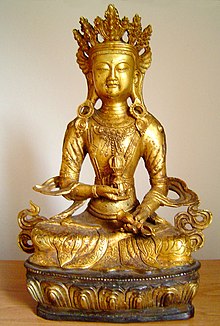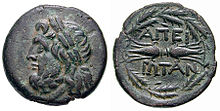Vajra
The Vajra ("wajra") or Dorje ("dordscheh") ( Sanskrit वज्र vajra ; Tibetan རྡོ་ རྗེ Dorje , Wylie rdo rje ; Japanese 金剛 kongō ) is a Buddhist ritual object. He is the essential symbol of Vajrayana ; the term Vajra gives this its name, and it is used in many different contexts for the Buddha's tantric teaching . For example, many deities are referred to as vajra deities, many traits and traits or states are referred to as vajra traits or states, and so on.
translation
Sanskrit vajra means "hard" or "powerful". The Tibetan equivalent dorje denotes the "king of stones" with its indestructible properties; its indestructible hardness and its indestructible radiance. In Buddhism it stands for "true reality". Like the diamond, this void is indestructible; H. immortal, because it has not been created. The flawless purity and transparency of the diamond symbolizes - despite all appearances - the perfect flawlessness of the void. In Hinduism , a myth tells that the lightning bolt Indras or his thunderbolt Vajra, which is said to be made from the bones of the Rishi Dadhichi, is a circular weapon with a hole in the middle. With this he should either kill his enemies or bring his fallen warriors back to life.
material
Originally, a vajra was supposed to be physically made from the “iron of heaven” (Tib .: gnam.lcags. ). A meteorite , i.e. a stone that falls from the sky, that burns down from nowhere as a shooting star or ball of fire to the earth, in order to bored into the earth as a metal, is a fitting image for the nature of the vajra as the inseparability of emptiness and Shape. According to the doctrine, meteorites "often appear in the middle of hailstorms, that is, of thunderstorms in which electrical discharges burn like arrows on the earth, with temperatures that are hotter than the sun, in order to leave the celestial metal in the earth." This object vajra is therefore seen as a weapon analogous to the forces of nature. Therefore the vajra made of meteorite is seen as an object with special qualities; Nowadays, at least in the Vajras of better quality, some of this substance is still used for production.
symbolism


According to the view of Buddhist teachings, the vajra symbolizes the unbreakable qualities of diamonds , the indestructible power of a thunderbolt and the inseparable clarity of space.
It centrally symbolizes the impenetrability, indivisibility, indivisibility, indestructibility, etc. of enlightenment , the state of Buddha as a vajra mind.
As the main symbol of enlightenment, it represents the inseparable perfection of the wisdom of the five Buddha families, as well as the goal of the bodies of the wisdom of these five families. The nine-spoke vajra symbolizes the five Buddhas of the five directions, as well as their companions. It also symbolizes the nine yanas or ways, with the center and the eight directions being counted.
use
In the Indian Vedas the vajra was already used around 500 to 1000 BC. Described as a metal rod with hundreds or thousands of spokes, which was commissioned by Indra , the lord of the gods. Historically, the use of the vajra as both a weapon and a scepter has been handed down; as a weapon it was thrown or wielded, and as a scepter the resemblance to the royal symbols of the west is obvious.
presentation
The vajra is the predominant attribute in all representations of deities or yidams of Vajrayana; with peaceful deities it is a scepter and an indestructible weapon with wrathful deities. The Vajra symbolizes the male principle, the method or the "skillful means" (English skilful Means ) which is held with the right hand or male. In Tibetan cult music it is mostly used together with a stemmed handbell (Skt .: ghanta ; Tib .: dril bu ), which symbolizes wisdom and is held with the left or female hand. Their common appearance, their common use represents the perfect union of "skill in the means" and wisdom. The use of the vajra and the term runs through all levels of Buddhist philosophy and practice and is inseparable from the entire teaching.
A vajra is represented with three, five, or nine spokes. The five- or nine-spoke versions are the most common in the tantric Buddhist traditions .
The five-spoke vajra is used as a symbol on countless ritual objects; it can also be found as an ornament, for example, on kilas ( phurbas ), knife knives and ritual sticks.
literature
- Rachel Storm (Ed.): The Encyclopedia of Eastern Mythology. Legends of the East: Myths and sagas of heroes, gods and warriors from ancient Egypt, Arabia, Persia, India, Tibet, China and Japan. Edition XXL, Reichelsheim 2000, ISBN 978-3-89736-305-2 (keyword Vajra )
- Anneliese and Peter Keilhauer: The Imagery of Hinduism. The Indian world of gods and their symbolism. DuMont, Cologne 1986, ISBN 3-7701-1347-0 , p. 220.
Web links
Individual evidence
- ↑ Rachel Storm: Vajra, Indra . In: Encyclopedia of Eastern Mythology. Reichelsheim 2000.

